Effective Strategies for Managing Behaviors of Concern in Healthcare
VerifiedAdded on 2020/07/22
|10
|1727
|421
Report
AI Summary
This report comprehensively addresses the topic of responding to behaviors of concern within healthcare settings. It systematically examines a range of challenging behaviors, including physical aggression, verbal aggression, confusion, intoxication, intrusive behavior, manipulation, noisiness, self-destructive behavior, and wandering. For each behavior, the report outlines the definition, potential causes, and three specific strategies for effective response. The document also discusses when to refer behaviors of concern to other health professionals and identifies five relevant professional roles. Finally, it considers legal and ethical considerations, particularly in aged care facilities, emphasizing the duty of care and the impact of strategies on residents' human rights. The report is supported by references to academic literature.
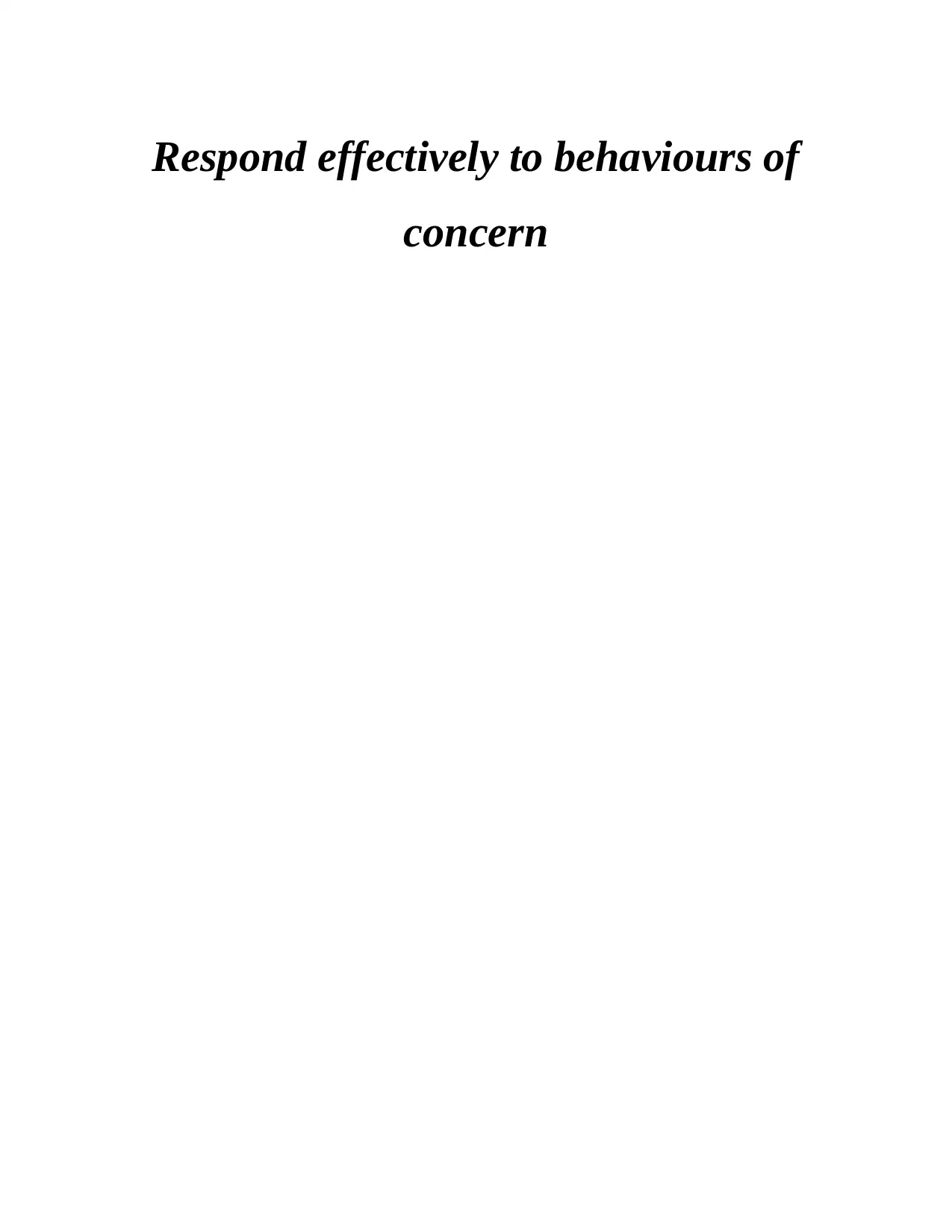
Respond effectively to behaviours of
concern
concern
Paraphrase This Document
Need a fresh take? Get an instant paraphrase of this document with our AI Paraphraser
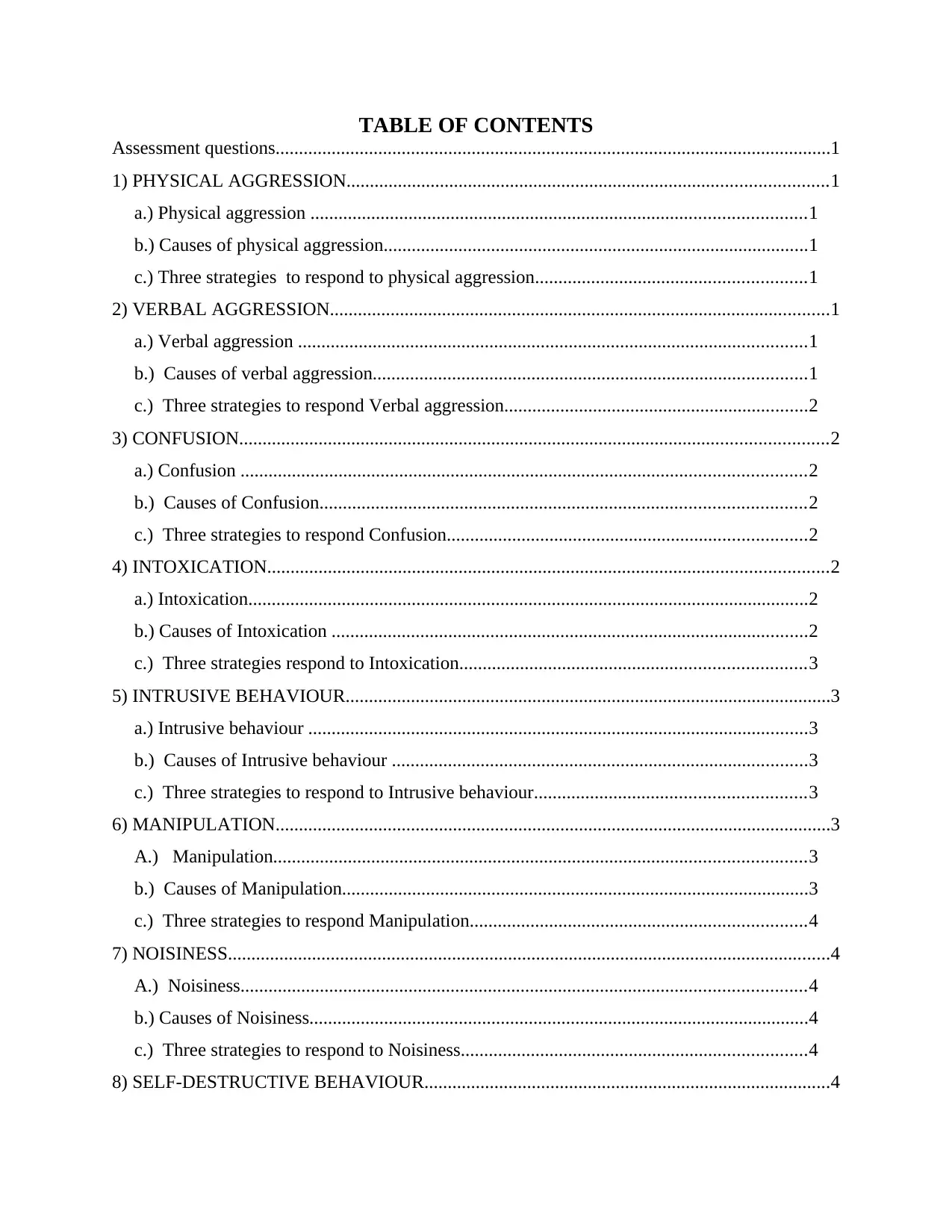
TABLE OF CONTENTS
Assessment questions.......................................................................................................................1
1) PHYSICAL AGGRESSION.......................................................................................................1
a.) Physical aggression ..........................................................................................................1
b.) Causes of physical aggression...........................................................................................1
c.) Three strategies to respond to physical aggression..........................................................1
2) VERBAL AGGRESSION...........................................................................................................1
a.) Verbal aggression .............................................................................................................1
b.) Causes of verbal aggression.............................................................................................1
c.) Three strategies to respond Verbal aggression.................................................................2
3) CONFUSION..............................................................................................................................2
a.) Confusion .........................................................................................................................2
b.) Causes of Confusion........................................................................................................2
c.) Three strategies to respond Confusion.............................................................................2
4) INTOXICATION........................................................................................................................2
a.) Intoxication........................................................................................................................2
b.) Causes of Intoxication ......................................................................................................2
c.) Three strategies respond to Intoxication..........................................................................3
5) INTRUSIVE BEHAVIOUR........................................................................................................3
a.) Intrusive behaviour ...........................................................................................................3
b.) Causes of Intrusive behaviour .........................................................................................3
c.) Three strategies to respond to Intrusive behaviour..........................................................3
6) MANIPULATION.......................................................................................................................3
A.) Manipulation..................................................................................................................3
b.) Causes of Manipulation....................................................................................................3
c.) Three strategies to respond Manipulation........................................................................4
7) NOISINESS.................................................................................................................................4
A.) Noisiness.........................................................................................................................4
b.) Causes of Noisiness...........................................................................................................4
c.) Three strategies to respond to Noisiness..........................................................................4
8) SELF-DESTRUCTIVE BEHAVIOUR.......................................................................................4
Assessment questions.......................................................................................................................1
1) PHYSICAL AGGRESSION.......................................................................................................1
a.) Physical aggression ..........................................................................................................1
b.) Causes of physical aggression...........................................................................................1
c.) Three strategies to respond to physical aggression..........................................................1
2) VERBAL AGGRESSION...........................................................................................................1
a.) Verbal aggression .............................................................................................................1
b.) Causes of verbal aggression.............................................................................................1
c.) Three strategies to respond Verbal aggression.................................................................2
3) CONFUSION..............................................................................................................................2
a.) Confusion .........................................................................................................................2
b.) Causes of Confusion........................................................................................................2
c.) Three strategies to respond Confusion.............................................................................2
4) INTOXICATION........................................................................................................................2
a.) Intoxication........................................................................................................................2
b.) Causes of Intoxication ......................................................................................................2
c.) Three strategies respond to Intoxication..........................................................................3
5) INTRUSIVE BEHAVIOUR........................................................................................................3
a.) Intrusive behaviour ...........................................................................................................3
b.) Causes of Intrusive behaviour .........................................................................................3
c.) Three strategies to respond to Intrusive behaviour..........................................................3
6) MANIPULATION.......................................................................................................................3
A.) Manipulation..................................................................................................................3
b.) Causes of Manipulation....................................................................................................3
c.) Three strategies to respond Manipulation........................................................................4
7) NOISINESS.................................................................................................................................4
A.) Noisiness.........................................................................................................................4
b.) Causes of Noisiness...........................................................................................................4
c.) Three strategies to respond to Noisiness..........................................................................4
8) SELF-DESTRUCTIVE BEHAVIOUR.......................................................................................4
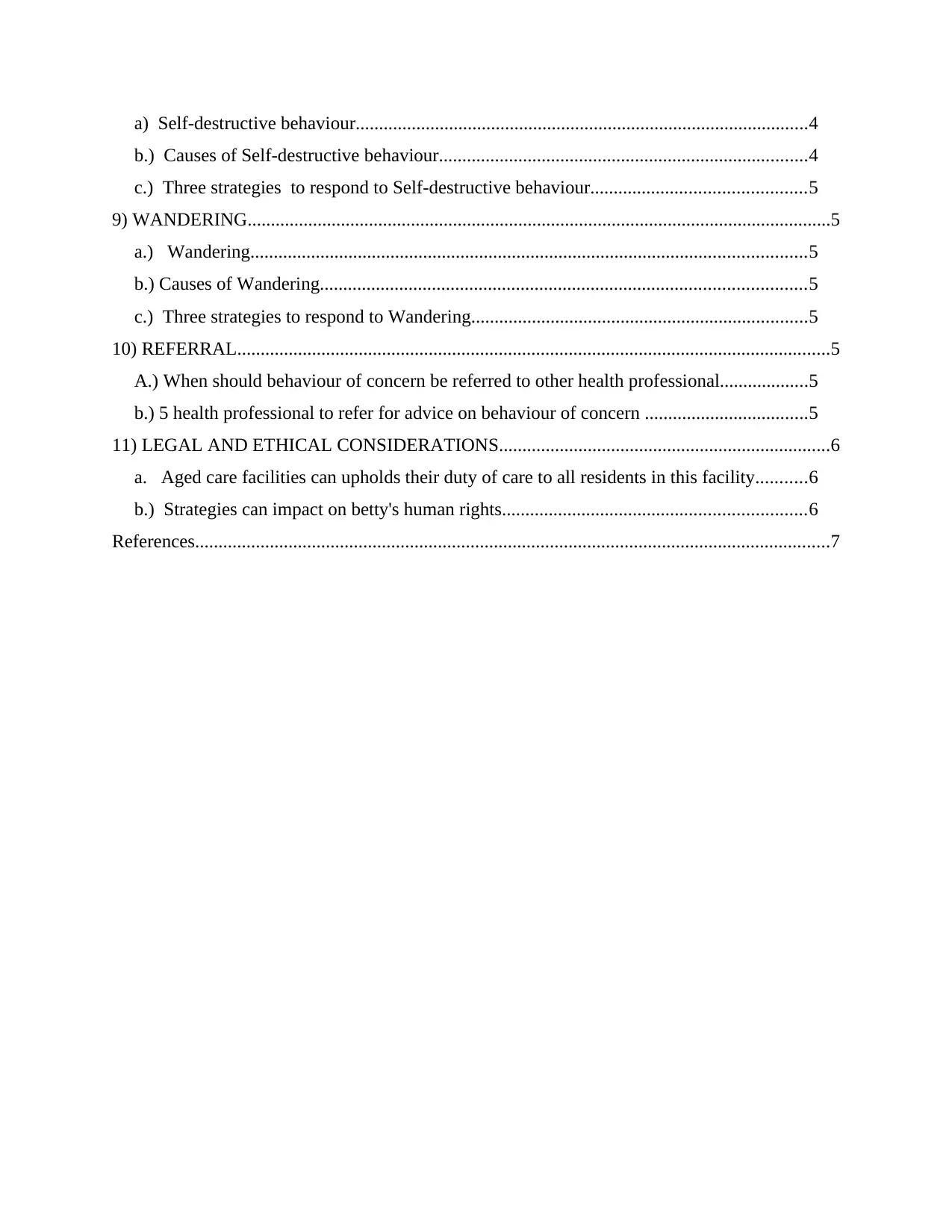
a) Self-destructive behaviour.................................................................................................4
b.) Causes of Self-destructive behaviour...............................................................................4
c.) Three strategies to respond to Self-destructive behaviour..............................................5
9) WANDERING.............................................................................................................................5
a.) Wandering.......................................................................................................................5
b.) Causes of Wandering........................................................................................................5
c.) Three strategies to respond to Wandering........................................................................5
10) REFERRAL...............................................................................................................................5
A.) When should behaviour of concern be referred to other health professional...................5
b.) 5 health professional to refer for advice on behaviour of concern ...................................5
11) LEGAL AND ETHICAL CONSIDERATIONS.......................................................................6
a. Aged care facilities can upholds their duty of care to all residents in this facility...........6
b.) Strategies can impact on betty's human rights.................................................................6
References........................................................................................................................................7
b.) Causes of Self-destructive behaviour...............................................................................4
c.) Three strategies to respond to Self-destructive behaviour..............................................5
9) WANDERING.............................................................................................................................5
a.) Wandering.......................................................................................................................5
b.) Causes of Wandering........................................................................................................5
c.) Three strategies to respond to Wandering........................................................................5
10) REFERRAL...............................................................................................................................5
A.) When should behaviour of concern be referred to other health professional...................5
b.) 5 health professional to refer for advice on behaviour of concern ...................................5
11) LEGAL AND ETHICAL CONSIDERATIONS.......................................................................6
a. Aged care facilities can upholds their duty of care to all residents in this facility...........6
b.) Strategies can impact on betty's human rights.................................................................6
References........................................................................................................................................7
You're viewing a preview
Unlock full access by subscribing today!
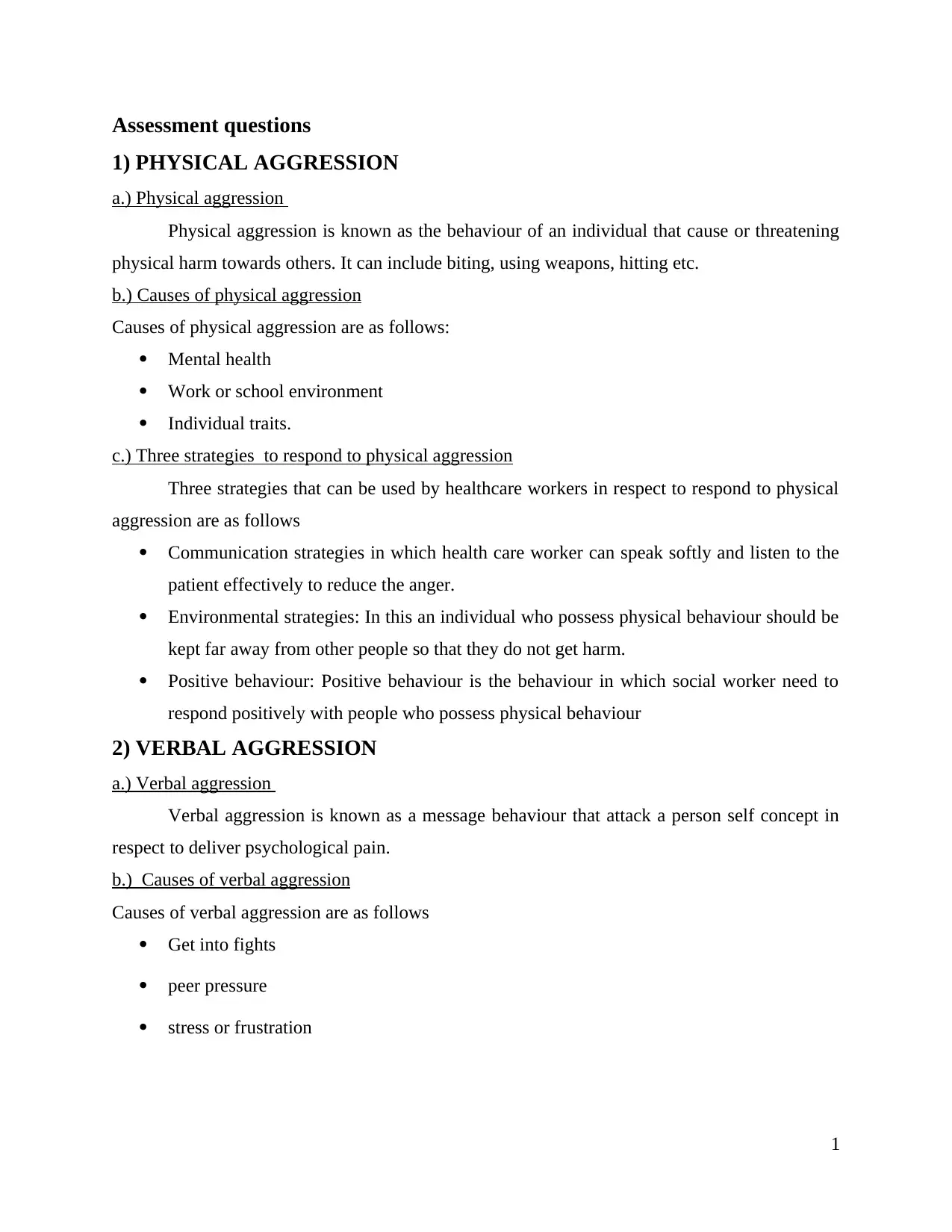
Assessment questions
1) PHYSICAL AGGRESSION
a.) Physical aggression
Physical aggression is known as the behaviour of an individual that cause or threatening
physical harm towards others. It can include biting, using weapons, hitting etc.
b.) Causes of physical aggression
Causes of physical aggression are as follows:
Mental health
Work or school environment
Individual traits.
c.) Three strategies to respond to physical aggression
Three strategies that can be used by healthcare workers in respect to respond to physical
aggression are as follows
Communication strategies in which health care worker can speak softly and listen to the
patient effectively to reduce the anger.
Environmental strategies: In this an individual who possess physical behaviour should be
kept far away from other people so that they do not get harm.
Positive behaviour: Positive behaviour is the behaviour in which social worker need to
respond positively with people who possess physical behaviour
2) VERBAL AGGRESSION
a.) Verbal aggression
Verbal aggression is known as a message behaviour that attack a person self concept in
respect to deliver psychological pain.
b.) Causes of verbal aggression
Causes of verbal aggression are as follows
Get into fights
peer pressure
stress or frustration
1
1) PHYSICAL AGGRESSION
a.) Physical aggression
Physical aggression is known as the behaviour of an individual that cause or threatening
physical harm towards others. It can include biting, using weapons, hitting etc.
b.) Causes of physical aggression
Causes of physical aggression are as follows:
Mental health
Work or school environment
Individual traits.
c.) Three strategies to respond to physical aggression
Three strategies that can be used by healthcare workers in respect to respond to physical
aggression are as follows
Communication strategies in which health care worker can speak softly and listen to the
patient effectively to reduce the anger.
Environmental strategies: In this an individual who possess physical behaviour should be
kept far away from other people so that they do not get harm.
Positive behaviour: Positive behaviour is the behaviour in which social worker need to
respond positively with people who possess physical behaviour
2) VERBAL AGGRESSION
a.) Verbal aggression
Verbal aggression is known as a message behaviour that attack a person self concept in
respect to deliver psychological pain.
b.) Causes of verbal aggression
Causes of verbal aggression are as follows
Get into fights
peer pressure
stress or frustration
1
Paraphrase This Document
Need a fresh take? Get an instant paraphrase of this document with our AI Paraphraser
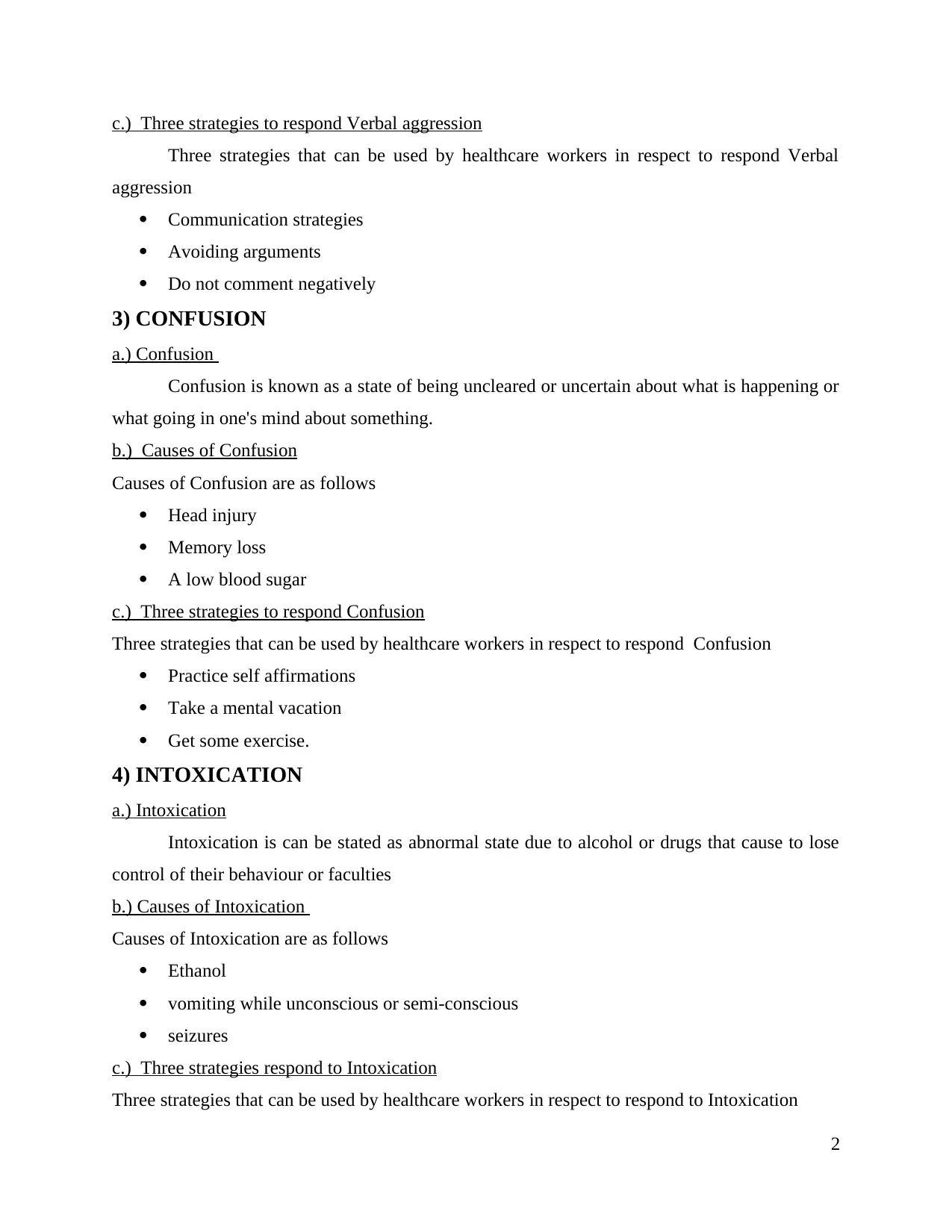
c.) Three strategies to respond Verbal aggression
Three strategies that can be used by healthcare workers in respect to respond Verbal
aggression
Communication strategies
Avoiding arguments
Do not comment negatively
3) CONFUSION
a.) Confusion
Confusion is known as a state of being uncleared or uncertain about what is happening or
what going in one's mind about something.
b.) Causes of Confusion
Causes of Confusion are as follows
Head injury
Memory loss
A low blood sugar
c.) Three strategies to respond Confusion
Three strategies that can be used by healthcare workers in respect to respond Confusion
Practice self affirmations
Take a mental vacation
Get some exercise.
4) INTOXICATION
a.) Intoxication
Intoxication is can be stated as abnormal state due to alcohol or drugs that cause to lose
control of their behaviour or faculties
b.) Causes of Intoxication
Causes of Intoxication are as follows
Ethanol
vomiting while unconscious or semi-conscious
seizures
c.) Three strategies respond to Intoxication
Three strategies that can be used by healthcare workers in respect to respond to Intoxication
2
Three strategies that can be used by healthcare workers in respect to respond Verbal
aggression
Communication strategies
Avoiding arguments
Do not comment negatively
3) CONFUSION
a.) Confusion
Confusion is known as a state of being uncleared or uncertain about what is happening or
what going in one's mind about something.
b.) Causes of Confusion
Causes of Confusion are as follows
Head injury
Memory loss
A low blood sugar
c.) Three strategies to respond Confusion
Three strategies that can be used by healthcare workers in respect to respond Confusion
Practice self affirmations
Take a mental vacation
Get some exercise.
4) INTOXICATION
a.) Intoxication
Intoxication is can be stated as abnormal state due to alcohol or drugs that cause to lose
control of their behaviour or faculties
b.) Causes of Intoxication
Causes of Intoxication are as follows
Ethanol
vomiting while unconscious or semi-conscious
seizures
c.) Three strategies respond to Intoxication
Three strategies that can be used by healthcare workers in respect to respond to Intoxication
2
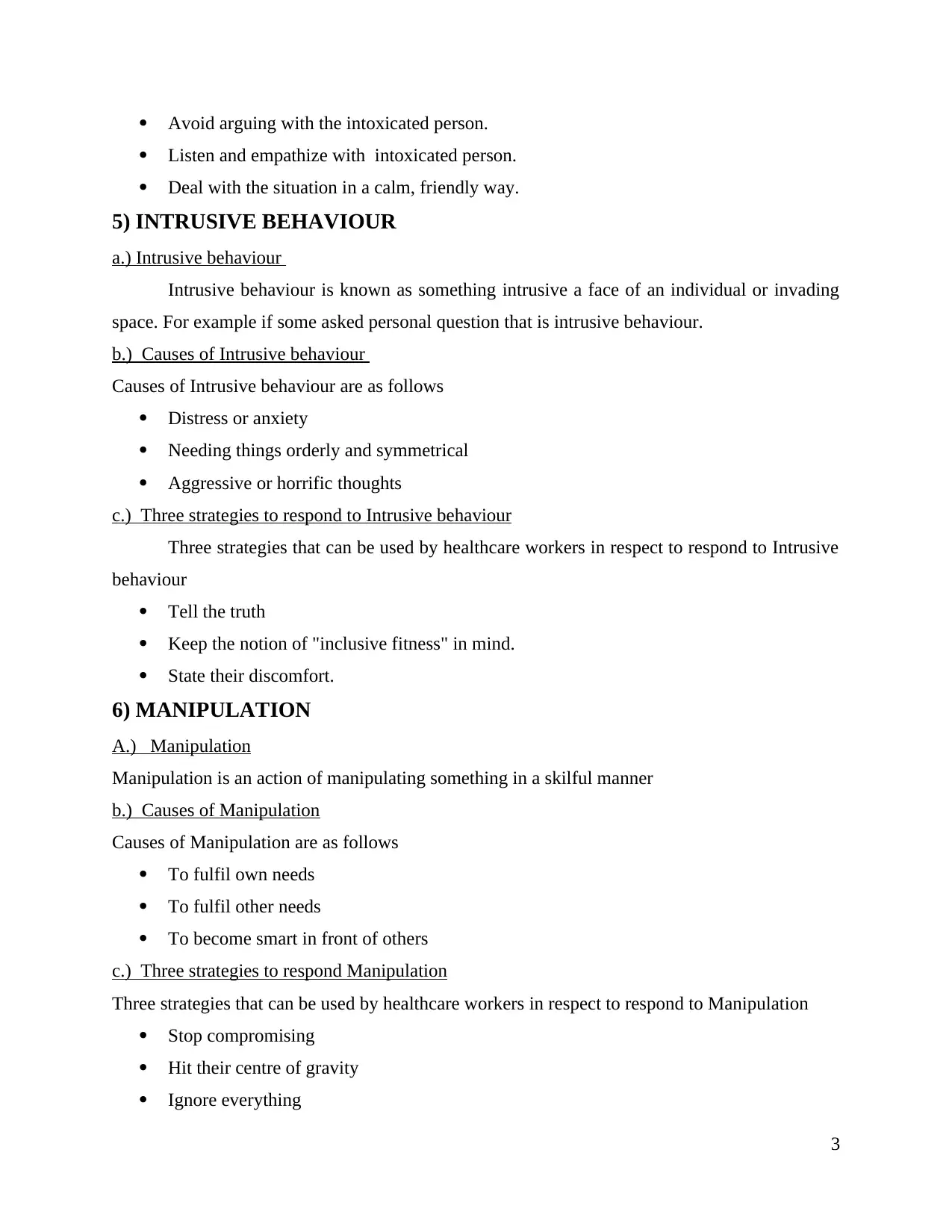
Avoid arguing with the intoxicated person.
Listen and empathize with intoxicated person.
Deal with the situation in a calm, friendly way.
5) INTRUSIVE BEHAVIOUR
a.) Intrusive behaviour
Intrusive behaviour is known as something intrusive a face of an individual or invading
space. For example if some asked personal question that is intrusive behaviour.
b.) Causes of Intrusive behaviour
Causes of Intrusive behaviour are as follows
Distress or anxiety
Needing things orderly and symmetrical
Aggressive or horrific thoughts
c.) Three strategies to respond to Intrusive behaviour
Three strategies that can be used by healthcare workers in respect to respond to Intrusive
behaviour
Tell the truth
Keep the notion of "inclusive fitness" in mind.
State their discomfort.
6) MANIPULATION
A.) Manipulation
Manipulation is an action of manipulating something in a skilful manner
b.) Causes of Manipulation
Causes of Manipulation are as follows
To fulfil own needs
To fulfil other needs
To become smart in front of others
c.) Three strategies to respond Manipulation
Three strategies that can be used by healthcare workers in respect to respond to Manipulation
Stop compromising
Hit their centre of gravity
Ignore everything
3
Listen and empathize with intoxicated person.
Deal with the situation in a calm, friendly way.
5) INTRUSIVE BEHAVIOUR
a.) Intrusive behaviour
Intrusive behaviour is known as something intrusive a face of an individual or invading
space. For example if some asked personal question that is intrusive behaviour.
b.) Causes of Intrusive behaviour
Causes of Intrusive behaviour are as follows
Distress or anxiety
Needing things orderly and symmetrical
Aggressive or horrific thoughts
c.) Three strategies to respond to Intrusive behaviour
Three strategies that can be used by healthcare workers in respect to respond to Intrusive
behaviour
Tell the truth
Keep the notion of "inclusive fitness" in mind.
State their discomfort.
6) MANIPULATION
A.) Manipulation
Manipulation is an action of manipulating something in a skilful manner
b.) Causes of Manipulation
Causes of Manipulation are as follows
To fulfil own needs
To fulfil other needs
To become smart in front of others
c.) Three strategies to respond Manipulation
Three strategies that can be used by healthcare workers in respect to respond to Manipulation
Stop compromising
Hit their centre of gravity
Ignore everything
3
You're viewing a preview
Unlock full access by subscribing today!
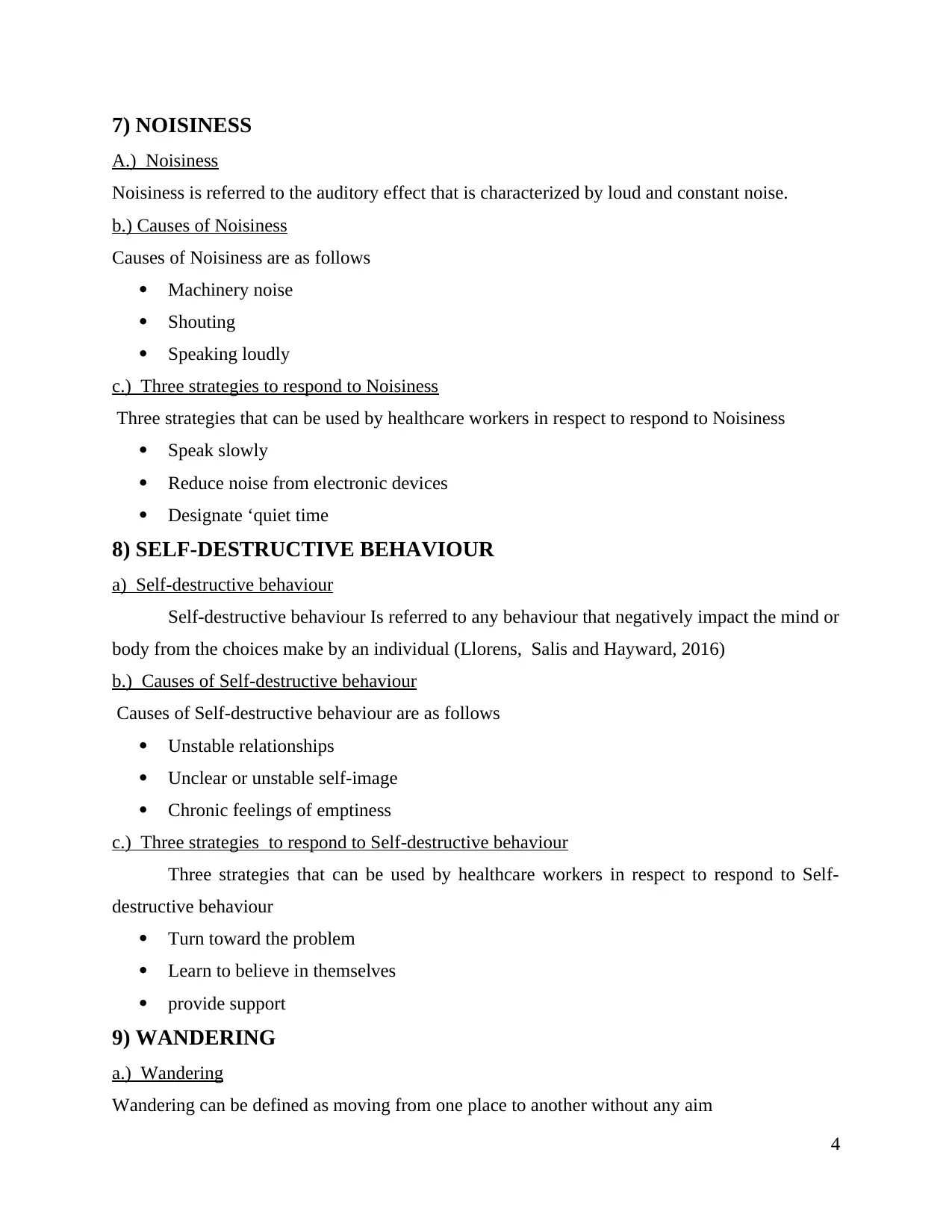
7) NOISINESS
A.) Noisiness
Noisiness is referred to the auditory effect that is characterized by loud and constant noise.
b.) Causes of Noisiness
Causes of Noisiness are as follows
Machinery noise
Shouting
Speaking loudly
c.) Three strategies to respond to Noisiness
Three strategies that can be used by healthcare workers in respect to respond to Noisiness
Speak slowly
Reduce noise from electronic devices
Designate ‘quiet time
8) SELF-DESTRUCTIVE BEHAVIOUR
a) Self-destructive behaviour
Self-destructive behaviour Is referred to any behaviour that negatively impact the mind or
body from the choices make by an individual (Llorens, Salis and Hayward, 2016)
b.) Causes of Self-destructive behaviour
Causes of Self-destructive behaviour are as follows
Unstable relationships
Unclear or unstable self-image
Chronic feelings of emptiness
c.) Three strategies to respond to Self-destructive behaviour
Three strategies that can be used by healthcare workers in respect to respond to Self-
destructive behaviour
Turn toward the problem
Learn to believe in themselves
provide support
9) WANDERING
a.) Wandering
Wandering can be defined as moving from one place to another without any aim
4
A.) Noisiness
Noisiness is referred to the auditory effect that is characterized by loud and constant noise.
b.) Causes of Noisiness
Causes of Noisiness are as follows
Machinery noise
Shouting
Speaking loudly
c.) Three strategies to respond to Noisiness
Three strategies that can be used by healthcare workers in respect to respond to Noisiness
Speak slowly
Reduce noise from electronic devices
Designate ‘quiet time
8) SELF-DESTRUCTIVE BEHAVIOUR
a) Self-destructive behaviour
Self-destructive behaviour Is referred to any behaviour that negatively impact the mind or
body from the choices make by an individual (Llorens, Salis and Hayward, 2016)
b.) Causes of Self-destructive behaviour
Causes of Self-destructive behaviour are as follows
Unstable relationships
Unclear or unstable self-image
Chronic feelings of emptiness
c.) Three strategies to respond to Self-destructive behaviour
Three strategies that can be used by healthcare workers in respect to respond to Self-
destructive behaviour
Turn toward the problem
Learn to believe in themselves
provide support
9) WANDERING
a.) Wandering
Wandering can be defined as moving from one place to another without any aim
4
Paraphrase This Document
Need a fresh take? Get an instant paraphrase of this document with our AI Paraphraser
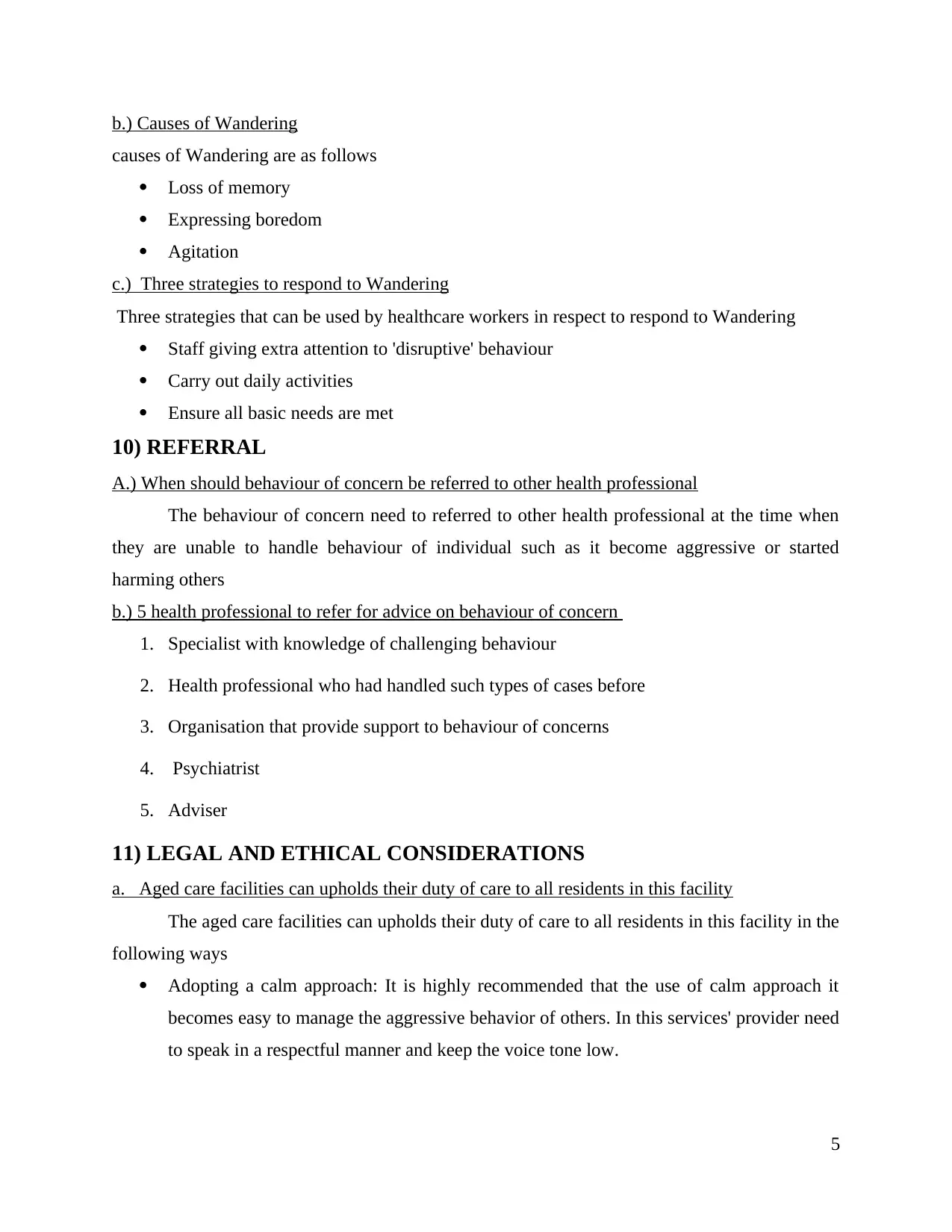
b.) Causes of Wandering
causes of Wandering are as follows
Loss of memory
Expressing boredom
Agitation
c.) Three strategies to respond to Wandering
Three strategies that can be used by healthcare workers in respect to respond to Wandering
Staff giving extra attention to 'disruptive' behaviour
Carry out daily activities
Ensure all basic needs are met
10) REFERRAL
A.) When should behaviour of concern be referred to other health professional
The behaviour of concern need to referred to other health professional at the time when
they are unable to handle behaviour of individual such as it become aggressive or started
harming others
b.) 5 health professional to refer for advice on behaviour of concern
1. Specialist with knowledge of challenging behaviour
2. Health professional who had handled such types of cases before
3. Organisation that provide support to behaviour of concerns
4. Psychiatrist
5. Adviser
11) LEGAL AND ETHICAL CONSIDERATIONS
a. Aged care facilities can upholds their duty of care to all residents in this facility
The aged care facilities can upholds their duty of care to all residents in this facility in the
following ways
Adopting a calm approach: It is highly recommended that the use of calm approach it
becomes easy to manage the aggressive behavior of others. In this services' provider need
to speak in a respectful manner and keep the voice tone low.
5
causes of Wandering are as follows
Loss of memory
Expressing boredom
Agitation
c.) Three strategies to respond to Wandering
Three strategies that can be used by healthcare workers in respect to respond to Wandering
Staff giving extra attention to 'disruptive' behaviour
Carry out daily activities
Ensure all basic needs are met
10) REFERRAL
A.) When should behaviour of concern be referred to other health professional
The behaviour of concern need to referred to other health professional at the time when
they are unable to handle behaviour of individual such as it become aggressive or started
harming others
b.) 5 health professional to refer for advice on behaviour of concern
1. Specialist with knowledge of challenging behaviour
2. Health professional who had handled such types of cases before
3. Organisation that provide support to behaviour of concerns
4. Psychiatrist
5. Adviser
11) LEGAL AND ETHICAL CONSIDERATIONS
a. Aged care facilities can upholds their duty of care to all residents in this facility
The aged care facilities can upholds their duty of care to all residents in this facility in the
following ways
Adopting a calm approach: It is highly recommended that the use of calm approach it
becomes easy to manage the aggressive behavior of others. In this services' provider need
to speak in a respectful manner and keep the voice tone low.
5
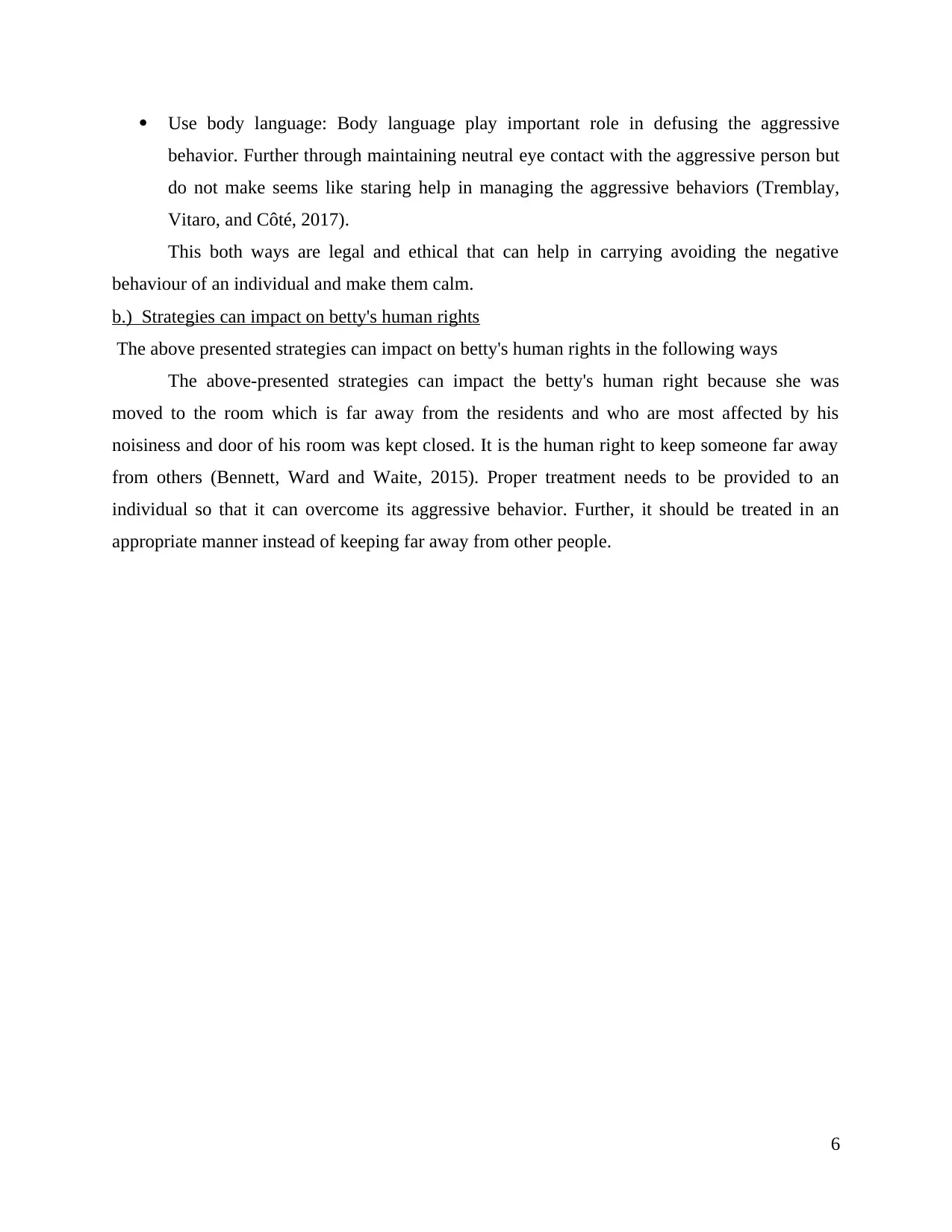
Use body language: Body language play important role in defusing the aggressive
behavior. Further through maintaining neutral eye contact with the aggressive person but
do not make seems like staring help in managing the aggressive behaviors (Tremblay,
Vitaro, and Côté, 2017).
This both ways are legal and ethical that can help in carrying avoiding the negative
behaviour of an individual and make them calm.
b.) Strategies can impact on betty's human rights
The above presented strategies can impact on betty's human rights in the following ways
The above-presented strategies can impact the betty's human right because she was
moved to the room which is far away from the residents and who are most affected by his
noisiness and door of his room was kept closed. It is the human right to keep someone far away
from others (Bennett, Ward and Waite, 2015). Proper treatment needs to be provided to an
individual so that it can overcome its aggressive behavior. Further, it should be treated in an
appropriate manner instead of keeping far away from other people.
6
behavior. Further through maintaining neutral eye contact with the aggressive person but
do not make seems like staring help in managing the aggressive behaviors (Tremblay,
Vitaro, and Côté, 2017).
This both ways are legal and ethical that can help in carrying avoiding the negative
behaviour of an individual and make them calm.
b.) Strategies can impact on betty's human rights
The above presented strategies can impact on betty's human rights in the following ways
The above-presented strategies can impact the betty's human right because she was
moved to the room which is far away from the residents and who are most affected by his
noisiness and door of his room was kept closed. It is the human right to keep someone far away
from others (Bennett, Ward and Waite, 2015). Proper treatment needs to be provided to an
individual so that it can overcome its aggressive behavior. Further, it should be treated in an
appropriate manner instead of keeping far away from other people.
6
You're viewing a preview
Unlock full access by subscribing today!
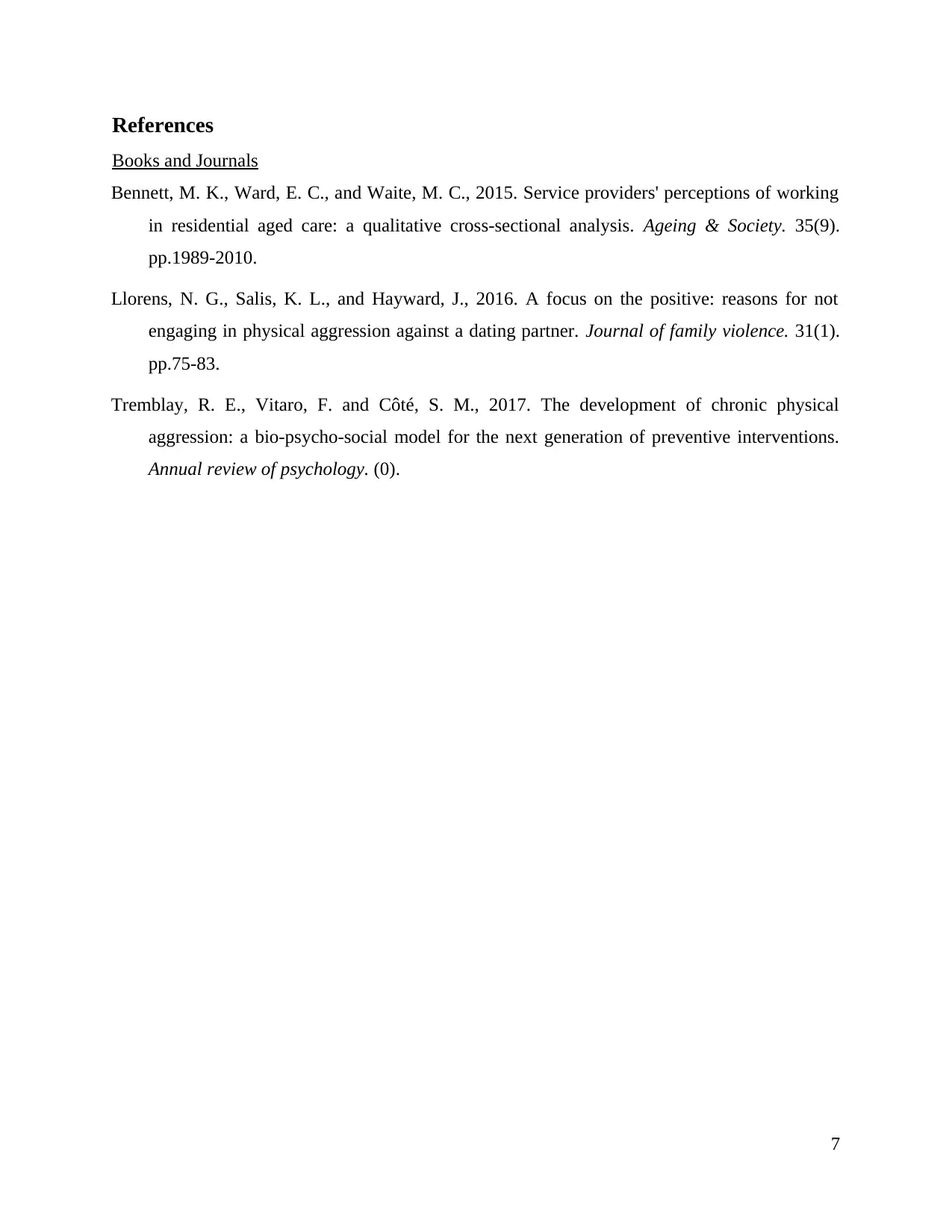
References
Books and Journals
Bennett, M. K., Ward, E. C., and Waite, M. C., 2015. Service providers' perceptions of working
in residential aged care: a qualitative cross-sectional analysis. Ageing & Society. 35(9).
pp.1989-2010.
Llorens, N. G., Salis, K. L., and Hayward, J., 2016. A focus on the positive: reasons for not
engaging in physical aggression against a dating partner. Journal of family violence. 31(1).
pp.75-83.
Tremblay, R. E., Vitaro, F. and Côté, S. M., 2017. The development of chronic physical
aggression: a bio-psycho-social model for the next generation of preventive interventions.
Annual review of psychology. (0).
7
Books and Journals
Bennett, M. K., Ward, E. C., and Waite, M. C., 2015. Service providers' perceptions of working
in residential aged care: a qualitative cross-sectional analysis. Ageing & Society. 35(9).
pp.1989-2010.
Llorens, N. G., Salis, K. L., and Hayward, J., 2016. A focus on the positive: reasons for not
engaging in physical aggression against a dating partner. Journal of family violence. 31(1).
pp.75-83.
Tremblay, R. E., Vitaro, F. and Côté, S. M., 2017. The development of chronic physical
aggression: a bio-psycho-social model for the next generation of preventive interventions.
Annual review of psychology. (0).
7
1 out of 10
Related Documents
Your All-in-One AI-Powered Toolkit for Academic Success.
+13062052269
info@desklib.com
Available 24*7 on WhatsApp / Email
![[object Object]](/_next/static/media/star-bottom.7253800d.svg)
Unlock your academic potential
© 2024 | Zucol Services PVT LTD | All rights reserved.





